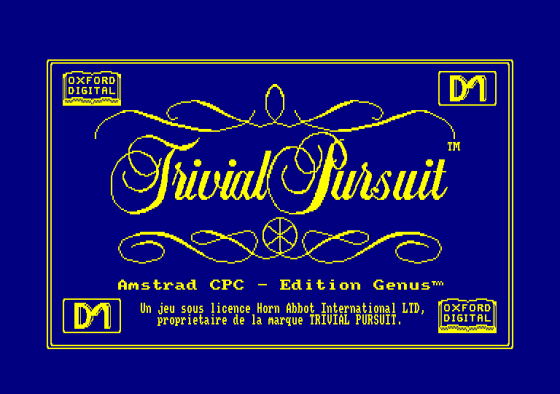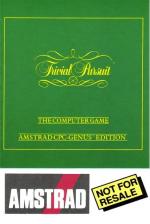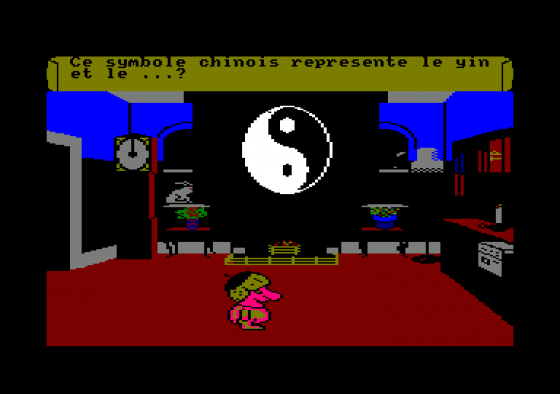
Amstrad Computer User
 1st November 1986
1st November 1986
Categories: Review: Software
Publisher: Domark
Machine: Amstrad CPC464
Published in Amstrad Computer User #24
Trivial Pursuit
You can't have missed it. Trivial Pursuit has been the board game of the Eighties. Neatly mixing Homo Sapien's compulsive competitiveness with his obsession with oddness, Trivial has belied its name as life-long friendships are shattered over the number of snakes in Hawaii.
Briefly, Trivial involves collecting six cheese-shaped pieces (wedges) from around a wheel shaped board. The wheel is divided into squares, most. of which have a subject such as science, entertainment, geography and so on associated with them. Land on a square, and vou have to answer a question on that. subject. Get it right and you can throw the dice again for the next square, else it's the next player's go.
Six of the squares are special. Land on one, answer correctly and you win a wedge for that subject. When you've got a full set you have to make for the hub of the wheel. Once there, you have to answer a question on a subject chosen by your opponents - and you've won.

The wheel structure of the board gives enough freedom of choice to allow elements of strategy to creep in. Do you go for Entertainment, which you're good at, or Science, which is nearer the wedge you want but less easy to answer? And so it goes on, into the small wee hours...
That's the board game. The computer version, happily, is even better. One of the disadvantages, I felt, of the low-tech game was that one person had to be Grand Inquisitor and thus couldn't play. On the Arnold this part is played by one T.P., a gambolling homunculus who picks a number between one and six for you. When you've picked your square, he wanders off to his library.
The library is a well-appointed room with a blazing fire, candle, hi-fi and other paraphernalia. Here, after pacing the carpet, T.P. asks a question. This can either be a textual query (like the original), musical (in three-part harmony), or graphical. There is a rich assortment of graphics which appear on a roll-down screen after the library lights have dimmed.

Musical questions are played on the hi-fi, which has an animated bar-graph display just like the real thing. This sort of attention to detail occurs throughout the game.
Pressing the fire button on the joystick reveals the answer. This is a bit of a departure from the board version, where if you got an answer wrong the questioner didn't have to reveal anything, but works well. Other additions to the original include a performance sheet for each player, a settable timer for the questions and a one-player mode.
There are sixteen blocks of questions (on the disc version) and a new one gets loaded in if a block gets exhausted during play. You can also load in a new block whenever you want - it's a good idea to do this every time you play, as this avoids repetition of questions.

Everything (apart from typing in names at the beginning) you need to do to play the game can be done from the joystick.
This makes things much easier if there's more than two of you, as it's simpler to pass a stick around than a computer. Everything about this adaptation recommends itself. The questions themselves are as singularly quirky as the real thing and the presentation is pretty damn hot.
Nigel
One day someone will take a computer program and turn it into a board game. For the moment things work the other way around. Scrabble was a programming triumph (watch out for the Joyce version out soon). Trivial Pursuit on the computer really adds to the game.
There are 3,000 questions: 1,000 from the original Genus I version, 1,000 new ones and 1,000 which use graphics or sound. When you have heard all questions, you can buy a new tape. You can find out who has answered the most questions, and who got the most right - an end to the argument that your younger sister beat you because she was just lucky.
Liz
I just love trivia. Where was Monopoly invented? (Atlanic City). Which members of the Royal family can vote? (All except the Queen). Prove to your friends that you know more useless facts than anyone else. My friends now refuse to play the board game with me - I'm not a had loser. I'm a dreadful winner. "Come on, everyone knows that."
You can still argue over whether Mao Sa Tung is the same thing as Chaiman Mao. If Domark isn't careful, it's going to get a very good reputation
Colin
There's only one way to test Trivial Pursuit and that involves a weekend, close friends and lashings of Liebfraumilch. Domark's doings pass this test with honours.
The MC, one T.P. (a Piman lookalike) squeaks, shuffles and skips his way through fiendish questions in the best tradition. The frills Domark has added are really useful, and as a whole it's even more fun than the real thing.
Great graphics, great 'gameplay', great fun. It almost hurts me to say this, but a classic.
Other Reviews Of Trivial Pursuit: Genus Edition For The Amstrad CPC464
Trivial Pursuit (Domark)
A review




